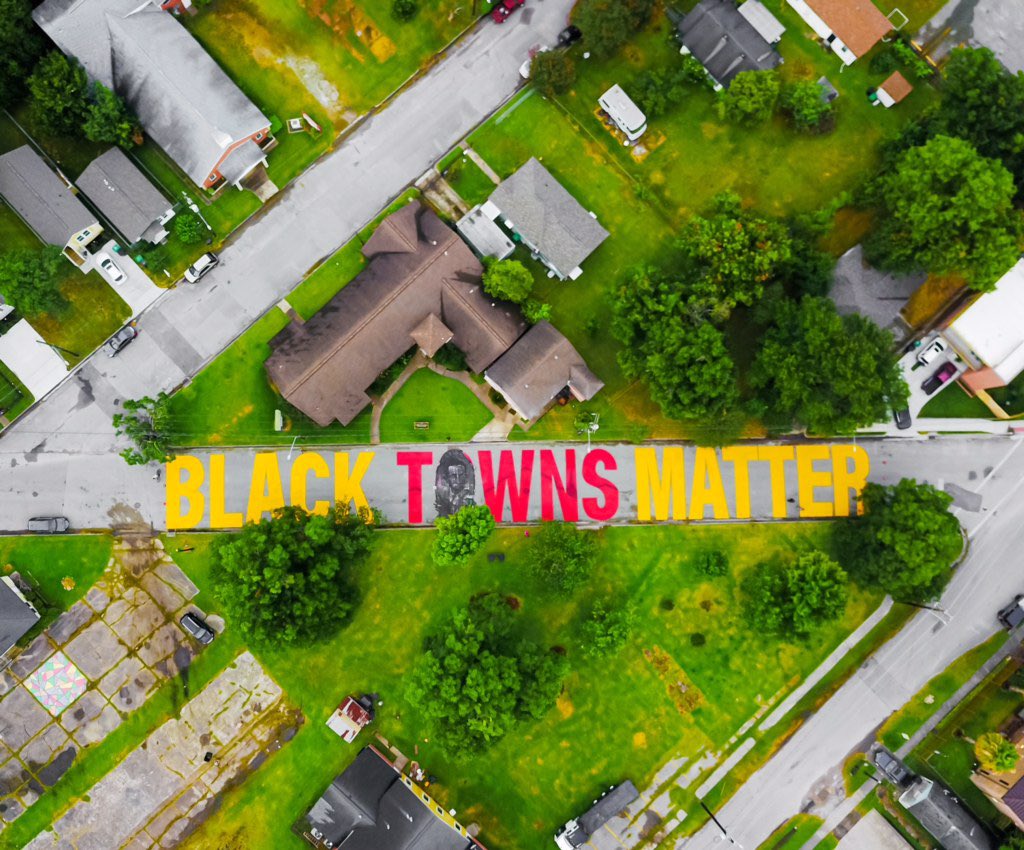The Black Lives Matter movement has arrested the national narrative focusing on the complicated history between Black Americans and law enforcement. Widespread cries for defunding local police departments are sweeping the nation, forcing local governments to reckon with Black people’s treatment and corporations to seek to understand the Black experience. However, there is limited discussion about the spaces that have historically kept Black people safe.

‘Black Towns Matter’ mural painted on street in Houston’s historic Independence Heights neighborhood. Image courtesy Twitter/#blacktownsmatter.
Black Towns Matter, too.
Former slaves founded Freedmen Towns throughout Texas from 1860-1920 in search of opportunity – an opportunity to earn, thrive, own, and learn – on their own. These municipalities were the centers of all things Black. Black economics, Black education, Black political advancement, the genesis, and blueprint of Black excellence with the intention of limited white involvement.
The Texas Freedom Colonies Project recently verified 347 remnants of Freedom Colonies, or these “Freedmen Towns” or “Settlements.” The Brookings Institution identified 13 small Black towns in Texas with populations under 1,000 in rural and urban regions.
But it is nearly impossible to identify the number of Freedmen Towns accurately. Many are missing on census records and historical maps. Blacks did not necessarily document their lives, and white institutions did not find value in it.
Nearly 150 years later, most of these towns have lost population and substantial land due to blatant theft or auction sales. Many have experienced permanent erasure due to the lack of historic preservation, poor land planning policies, and limited (or no) advocacy on their behalf. Oftentimes, these communities have become victims of city annexation – disregarding cultural practices and priorities.
But, Black Towns Matter, too.
Prairie View A&M is the only HBCU and university in Texas offering a graduate degree in community development and will soon offer an African American Studies program. As an institution, we are in the best position to underscore the importance of preserving Black Towns with our students, research, and interdisciplinary faculty expertise that includes architecture, historic preservation, agriculture, economic development, real estate, social work, public health and more. Prairie View A&M embodies the same shared history, mission, and credibility as many founders of Freedmen Towns and their descendants.
I am leveraging the identity and resources of Prairie View A&M by centering student service-learning, and community-engaged research efforts for the advancement and protection of Piney Point, Houston’s forgotten Freedmen’s Town, founded in 1865 by Reverend Mack Austin and Sister Sarah Hannah, both freed slaves.
Five neighborhoods were created within the Piney Point settlement – Blossom Heights, Harlem Heights, Ullrich, Piney Point, and Carver Crest–where only one hundred lots remain while being valued as some of Houston’s most expensive real estate. Aggressive forms of commercial and residential gentrification, poor planning policies, contemporary immigration, and the lack of interest from younger generations to uphold the integrity of the historic neighborhood have nearly erased the community nestled between Westheimer/Fondren/Richmond in Midwest Houston.
Our work in the classroom and the Piney Point community has initiated the collection of oral histories, archives, the establishment of a community action plan, and funded research efforts to best support their priorities and promote their story – our story.
In true form, most freed slaves purchased land to create a school, church, and cemetery ‘for the descents of African people.’ Today, all three continue to exist in Piney Point. Pilgrims Rest Missionary Baptist Church, the first Black church in Harris County. Piney Point Elementary and a cemetery soon followed that remains nestled off Westheimer and Crossview – in desperate need of someone willing to unearth the ancestors’ stories who pioneered a new life.
Freedmen Towns typically settled near each other. Additional Freedmen Towns identified in the Houston area include McGee, Frenchtown, Sunnyside, Independence Heights, Riceville, and Lilly White – all with unique and riveting histories with more to be resurrected, like Little Egypt in Dallas – uncovered due to a university taking an interest.
Black Towns Matter, too.
Prairie View can take an interest in Black Towns, too, with the anticipated Ruth J. Simmons Center on Slavery and Justice. Now is the time to consider how we can contribute to deep investment and partnership in these communities.
As a campus community, we must also inquire of ourselves how we redefine community and campus efforts outside of our situated place in the city of Prairie View. Who could we be as an institution if we shifted our service learning to directly benefit of restoration, preservation, and investment of the 13 remaining Black Towns in Texas? Who could we be as an institution if we expanded our pedagogy excellence with a community-engaged research footprint – allowing us to secure substantial competitive funding – and become authorities in safe places for Black people? Who could we be if we allowed our classrooms to serve as incubators for the next generation of pioneers prepared to reclaim these Black free spaces for themselves?
Doing so could reunite Prairie View back to her original mission as a land-grant institution – with a fierce purpose of not only producing productive people but putting the people first.
Black Towns Matter, too.
Tiffany D. Thomas is a program coordinator and assistant professor of community development in Prairie View A&M University’s School of Architecture.

